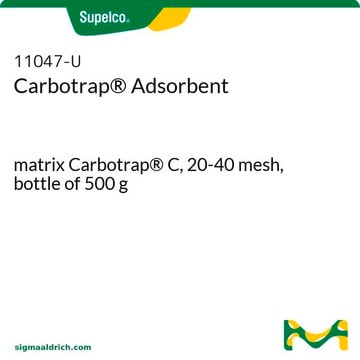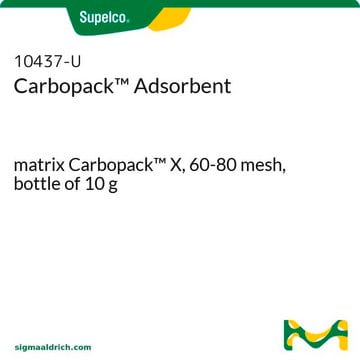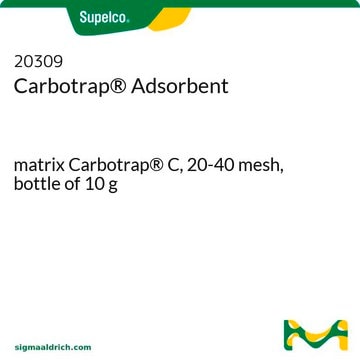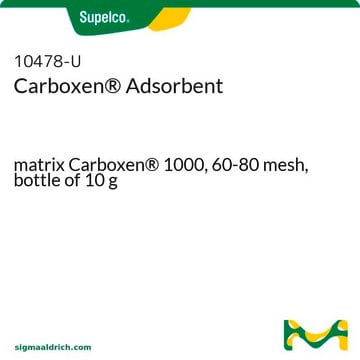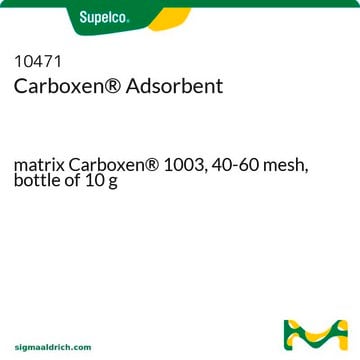10435-U
Carbotrap® Carbon Adsorbent
matrix Carbotrap® X, 20-40 mesh, bottle of 10 g
About This Item
Prodotti consigliati
Nome del prodotto
Carbotrap® Adsorbent, matrix Carbotrap® X, 20-40 mesh, bottle of 10 g
Nome Commerciale
Carbotrap®
Stato
granular
Confezionamento
bottle of 10 g
tecniche
LPLC: suitable
Area superficiale
~240 m2/g
Matrice
Carbotrap® X
Gruppo funzionale matrice
carbon
Dimensione particelle
20-40 mesh
Dimensione pori
~0.62 cm3/g mesoporosity
~0 cm3/g macroporosity
~0 cm3/g microporosity
~100 Å pore diameter
Densità
~0.44 g/mL (free fall density)
Tecnica di separazione
reversed phase
Cerchi prodotti simili? Visita Guida al confronto tra prodotti
Descrizione generale
- Granular
- Friable
- Used for molecules with an analyte size relative to C3-C20+ n-alkanes
- Hydrophobic (can be used in high humidity environments)
Generally, GCB adsorbents offer weaker relative adsorptive strength compared to carbon molecular sieve (CMS) adsorbents, and similar relative adsorptive strength compared to spherical graphitized polymer carbon (SGPC) adsorbents. Our Carbotrap products are a type of GCB adsorbent.
- Particles are 20/40 mesh
- These large particles allow high flow rates without excessive pressure drops
For more information about any of our specialty carbon adsorbents, please visit sigma-aldrich.com/carbon
Note legali
Codice della classe di stoccaggio
11 - Combustible Solids
Classe di pericolosità dell'acqua (WGK)
nwg
Punto d’infiammabilità (°F)
Not applicable
Punto d’infiammabilità (°C)
Not applicable
Dispositivi di protezione individuale
Eyeshields, Gloves, type P3 (EN 143) respirator cartridges
Scegli una delle versioni più recenti:
Certificati d'analisi (COA)
It looks like we've run into a problem, but you can still download Certificates of Analysis from our Documenti section.
Se ti serve aiuto, non esitare a contattarci Servizio Clienti
Possiedi già questo prodotto?
I documenti relativi ai prodotti acquistati recentemente sono disponibili nell’Archivio dei documenti.
I clienti hanno visto anche
Articoli
Synthetic CMS carbons offer tailored adsorbents for specific applications.
Active Filters
Il team dei nostri ricercatori vanta grande esperienza in tutte le aree della ricerca quali Life Science, scienza dei materiali, sintesi chimica, cromatografia, discipline analitiche, ecc..
Contatta l'Assistenza Tecnica.